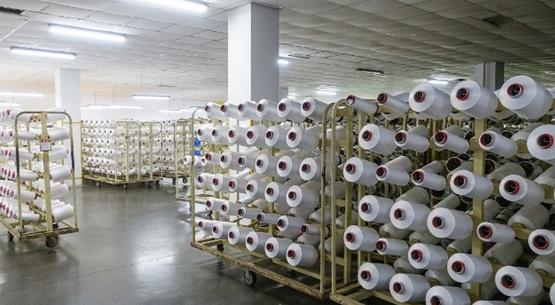Textile industry "14th Five-Year" scientific and technological development guidance
With the rapid progress of key common technologies and equipment such as molding, composite and functional finishing, industrial textiles are used in the fields of safety protection such as emergency rescue, flood rescue, and Marine oil spill disposal, the aerospace fields such as Tiangong, Beidou series satellites, Shenzhou spacecraft, carrier rockets, and Tiansen 1, and the infrastructure construction fields such as airports and expressways. Both have played an important role in strategic support and material support. Ultra-low emission filter materials help environmental protection projects; The intelligent geoglass realizes the monitoring and early warning of the main body of the project, and the expansion and application of coarse denier polypropylene filament geotextile improves the quality of infrastructure. Dual-use products and technologies such as ultra-fine wire warp knitting, self-lubricating fabrics, multifunctional flight suits and personal protective equipment have played an important role in the construction of aerospace and national defense. Technological breakthroughs such as two-component spunbonded spunlace and multi-jet electrostatic spinning have further enhanced the industrial strength of China's medical and health textiles.

3. Steady improvement of green manufacturing technology
New textile green processing technologies continue to emerge and are steadily promoted and applied in the industry. During the "13th Five-Year Plan" period, the water consumption per unit product of the printing and dyeing industry decreased by 17%, and the water reuse rate increased from 30% to 40%. The cumulative reduction of wastewater discharge and major pollutant discharge in the textile industry is more than 10%. Continuous open width pretreatment of knitted fabrics, continuous open width pretreatment of chemical fiber woven fabrics, low salt and low alkali reactive dye dyeing, cold rolling pile dyeing, foam finishing, fluorine-free waterproof finishing and other technologies have been further expanded. The key technologies such as salt-free dyeing of reactive dyes, dyeing with liquid disperse dyes and printing with low urea reactive dyes have been industrialized. Important progress has been made in the research and development of key technologies such as supercritical carbon dioxide fluid dyeing, full process open-width pad dyeing of tension-sensitive fabrics, and continuous dyeing of polyester fabrics with less water.
China's scientific and technological innovation ability of recycling chemical fiber has been significantly improved, and the resource utilization level of waste textiles has been further improved. The key technologies and equipment of recycled polyester have formed a number of innovative achievements, including continuous drying by physical method, multistage filtration technology, liquid phase thickening by physical and chemical method, online full chromatographic complementary color toning technology, efficient differentiation technology, and chemical depolymerization, filtration separation, decolorization, refining, polycondensation and functional modification.
4. Remarkable effect of intelligent upgrading and transformation of the industry
Remarkable progress has been made in the intellectualization of textile processing processes and in the level of equipment technology. Remarkable results have been achieved in the construction of intelligent production lines for chemical fiber, spinning, printing and dyeing, clothing, and home textiles. Breakthroughs have been made in a number of key stand-alone machines and equipment such as cotton spinning and combing machines, high-performance special knitting equipment, and automatic computerized flat knitting machines. The chemical fiber intelligent demonstration factory and intelligent workshop realize the automatic production of the whole process, such as sending slices, winding automatic yarn, online detection, automatic packaging, intelligent storage, etc. The new generation of CNC technology for cotton spinning has been widely used, and a number of automated and digital spinning production lines have been built, reducing the number of workers to 15 people. Printing and dyeing automation and digitalization continue to upgrade, digital automatic dyeing of bobbin yarn to the direction of intelligent factory; The development speed of intelligent clothing manufacturing has accelerated significantly, and has initially formed an information integrated management system including automated production processes and inspection, storage and transportation, information traceability, and store management, including body measurement, design, fitting, and processing. The overall solution for large-scale personalized customization is becoming increasingly mature, and a number of advanced intelligent system platforms for large-scale personalized customization of clothing have emerged. There are more than 300 automatic production lines for home textile bedding, towels and curtains, and the production efficiency and quality have been significantly improved.
5. Continuous improvement of industry standard system construction
- EMERSON
- Honeywell
- CTI
- Rolls-Royce
- General Electric
- Woodward
- Yaskawa
- xYCOM
- Motorola
- Siemens
- Rockwell
- ABB
- B&R
- HIMA
- Construction site
- electricity
- Automobile market
- PLC
- DCS
- Motor drivers
- VSD
- Implications
- cement
- CO2
- CEM
- methane
- Artificial intelligence
- Titanic
- Solar energy
- Hydrogen fuel cell
- Hydrogen and fuel cells
- Hydrogen and oxygen fuel cells
- tyre
- Chemical fiber
- dynamo
- corpuscle
- Pulp and paper
- printing
- fossil
- FANUC
- Food and beverage
- Life science
- Sewage treatment
- Personal care
- electricity
- boats
- infrastructure
- Automobile industry
- metallurgy
- Nuclear power generation
- Geothermal power generation
- Water and wastewater
- Infrastructure construction
- Mine hazard
- steel
- papermaking
- Natural gas industry
- Infrastructure construction
- Power and energy
- Rubber and plastic
- Renewable energy
- pharmacy
- mining
- Plastic industry
- Schneider
- Kongsberg
- NI
- Wind energy
- International petroleum
- International new energy network
- gas
- WATLOW
- ProSoft
- SEW
- wind
- ADVANCED
- Reliance
- YOKOGAWA
- TRICONEX
- FOXBORO
- METSO
- MAN
- Advantest
- ADVANCED
- ALSTOM
- Control Wave
- AB
- AMAT
- STUDER
- KONGSBERG
- MOTOROLA
- DANAHER MOTION
- Bently
- Galil
- EATON
- MOLEX
- Triconex
- DEIF
- B&W
- ZYGO
- Aerotech
- DANFOSS
- KOLLMORGEN
- Beijer
- Endress+Hauser
- MOOG
- KB
- Moxa
- Rexroth
- YAMAHA
- Johnson
- Westinghouse
- WAGO
- TOSHIBA
- TEKTRONIX


Email:wang@kongjiangauto.com



































































































































